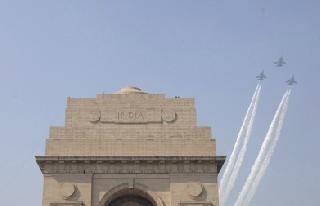An unrelated file photo.
NEW DELHI (PTI): With the indigenous nuclear submarine INS Arihant set to be launched for sea trials in few weeks, India will soon complete its nuclear triad giving it the capability to respond to nuclear strikes from sea, land and air-based systems.
Indian Navy sources said INS Arihant was going through harbour acceptance trials phase where it did not face any hiccups and was ready for the sea trials, which are expected to be completed by the end of this year.
"INS Arihant will provide us with the option for sea-based strategic deterrence, the third leg of the triad," Assistant Chief of Navy Staff (Submarine) Rear Admiral L Sarat Babu told reporters.
Attaining a nuclear triad would be significant for India, which has a 'no first-strike' policy regarding the use of its nuclear weapons and requires a strong retaliatory capability as a deterrence.
He said the submarine achieved a major milestone by achieving criticality of its nuclear reactor on August 10, 2013 and "the next milestone would be when Arihant puts to sea for her sea trials."
"It would be Navy's efforts to provide every possible assistance and support during the conduct of these extensive 'first of class' trials," Babu said.
On the INS Chakra submarine leased from Russia, Babu said the vessel during its around one-and-a-half years with the force has been helping Navy hone its skill of integrating nuclear submarines across the entire spectrum of naval operations.
"Presently, a part of the crew comprises those who have been trained in India, thus indicating that Navy has also attained self sufficiency in training personnel for operating such complex platforms besides operations and maintenance," he said.
The officer said the size of Navy's nuclear submarine fleet would depend on the "maritime security dynamics in the Indian Ocean Region (IOR) and our extended neighbourhood would dictate our overall plans to augment our fleet."
Babu said INS Chakra would facilitate the Navy in maintaining a strong, stabilising and credible presence in the IOR.
Navy sources said during the sea trials of Arihant, the submarine will carry out the firing of missiles such as the K-15, which are submarine-launched weapon systems tested and developed indigenously by the DRDO last year.
Only four other countries -- China, France, Russia and the United States -- have the capability to produce submarine launched ballistic missiles (SLBMs). Although the UK deploys such missiles, they are believed to be produced in the US.
India is developing a number of SLBMs including the K-15, which was tested last year and has a range of over 700 km. Under this programme, the DRDO is also believed to be working on a longer-range missile.
Meanwhile, commenting on the recent incident where Navy's submarine INS Sindhughosh was about to run aground while entering the Mumbai harbour, Navy sources attributed it to the silting which has resulted in reducing the water depth there.
He said authorities concerned have given permission for dredging there and work in this regard was already in progress.
Last Friday, the submarine had encountered a situation where there was very less water in the harbour but it held to its position using ropes and other means to avoid getting grounded, they said.
The incident came almost six months after the Navy lost its latest submarine INS Sindhurakshak after an explosion in its torpedo section, killing all the 18 personnel on board.
 Previous Article
Previous Article Next Article
Next Article













The Indian Air Force, in its flight trials evaluation report submitted before the Defence Ministry l..
view articleAn insight into the Medium Multi-Role Combat Aircraft competition...
view articleSky enthusiasts can now spot the International Space Station (ISS) commanded by Indian-American astr..
view article